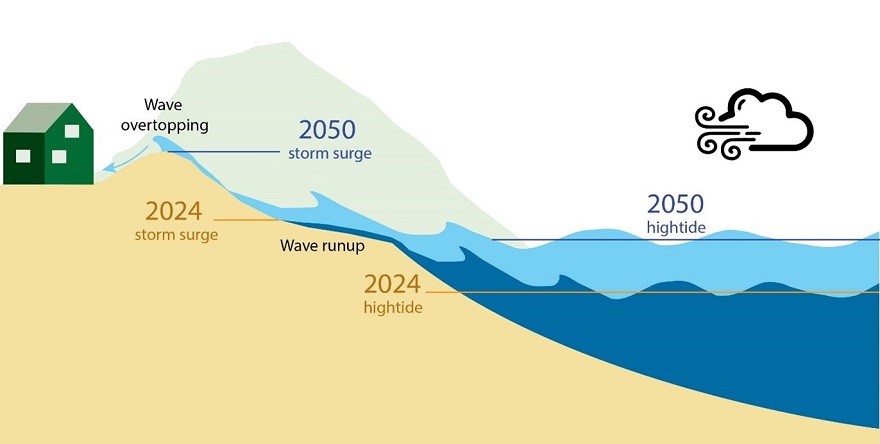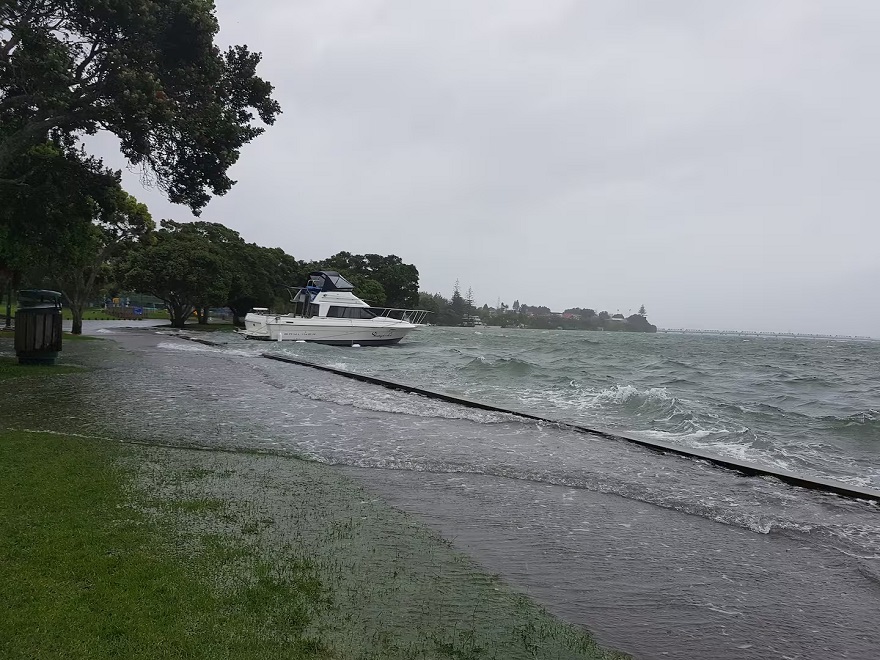We’re continually working to identify areas likely to be affected by coastal flooding as sea level rises.
What is coastal flooding?
Coastal flooding happens when an increase in sea level enables seawater to flood normally dry low lying land. Typically driven by storms where low air pressure and strong winds driving large waves combine low-lying storm surge. This can be worsened by high or spring/king tides.
Climate induced sea level rise will increase the extent and frequency of flooding, eventually leading to sunny day flooding where flooding occurs with no storm. Find out more about predicted sea level rise around New Zealand.

Schematic figure of how rising sea level will impact coastal flooding.
Coastal flooding in Tauranga
Tauranga has a long history of being impacted by large storms, the most significant of which are ex-tropical cyclones coming south from the tropics. One of the most significant storms to affect Tauranga was ex-tropical Cyclone Giselle. This storm crossed the North Island on April 9, 1968, and travelled down the east coast of the country causing widespread damage as well as leading to the Wahine disaster. The storm generated a 0.88m high storm surge in Tauranga Harbour, the second highest ever recorded in New Zealand.
Over the last 30 years several other ex-tropical cyclones such as Fergus (1997), Ivy (2008), and Pam (2015) have also impacted the Bay of Plenty causing damage through coastal flooding, high winds, and heavy rainfall. On January 5, 2018, a low-pressure storm coincided with a king tide to produce flooding across Tauranga.

The sea flooding on to normally dry land at Memorial Park during a low-pressure storm in January 2018. Photo – Bay of Plenty Times.
Maps of coastal flooding
Coastal flooding maps identify land that is potentially at risk of flooding from the sea, especially during storms, both with and without sea level rise.
Coastal flooding maps are not a prediction of flooding. Modelling dynamic events such as storms is complex and requires specific inputs for tide, wind, and shoreline shape. Instead, the maps are an estimate of areas susceptible to flooding during storms at current sea level and as sea level rises.
Coastal flooding maps of Tauranga Harbour produced by NIWA were released in 2019. Bay of Plenty Regional Council have subsequently commissioned NIWA to produced maps of coastal flooding for the rest of the Bay of Plenty region, including the coastal strip of Tauranga.
The coastal flooding map for the harbour was produced using a dynamic model that calculates the flow of seawater on the coast, accounting for the effects of tide, atmospheric pressure, and wind as well as the flow of water as waves break on the shore.
For more information about the methods used to produce the maps, and their limitations, you can find the technical report for the inner harbour here:
NIWA Tauranga Harbour Inundation Modelling full report (10mb pdf) NIWA - Tauranga Harbour Inundation Modelling 2019 Executive summary (81kb pdf)
Coastal flooding for the harbour viewer
You can see and explore the maps produced by this study via an online viewer. This viewer allows you to select a specific property and find the current coastal flooding area as well as potential flooding for a range of sea level rise scenarios and storm event likelihoods.
To use the coastal flooding map viewer:
- Open the viewer using the link below
- Click on the magnifying glass symbol at the top right
Inundation map viewer